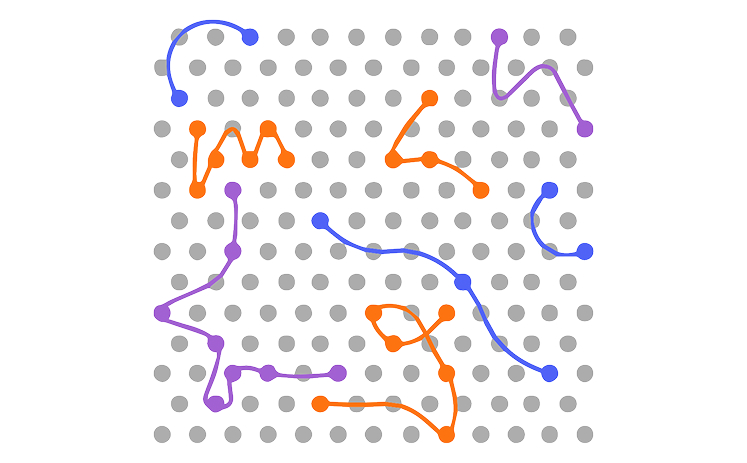Long-Read Sequencing Technology
Deeper insights into complex genomic regions with long reads
Long-read sequencing technology can help resolve challenging regions of the genome, such as highly repetitive and highly homologous regions
What is long-read sequencing?
Long-read sequencing is a DNA sequencing approach that enables the sequencing of much longer DNA fragments than traditional short-read sequencing methods. While short reads can capture the majority of genetic variation, long-read sequencing allows the detection of complex structural variants in the genome that may be difficult to detect with short reads. These include large inversions, deletions, or translocations, some of which have been implicated in genetic disease.
Advantages of long-read sequencing
Long-read sequencing technology can help resolve challenging regions of the genome by sequencing thousands of bases to:
- Resolve traditionally difficult to map genes or regions of the genome, such as those containing homology to other regions or highly repetitive elements
- Perform phased sequencing to identify co-inherited alleles, haplotype information, and phase de novo mutations
- Generate long reads for de novo assembly and genome finishing applications
Long-range genomic insights
Illumina mapped read technology provides long-distance genomic information that can help scientists detect large structural variants and resolve challenging-to-map regions. While technically a short-read technology, Illumina mapped reads leverage on-flow cell library preparation and novel informatics that incorporate proximity information from clusters in neighboring nanowells to generate accurate long-range genomic insights. The unique workflow maintains the link between the original long DNA template and the resulting short sequencing reads, enabling enhanced detection of structural variants, ultra-long phasing of genetic variants, and improved mapping in low-complexity regions.

How does Illumina mapped read technology work?
DNA templates are extracted from samples using standard or high molecular weight methods and introduced directly to the flow cell surface, where they are captured, transformed into clusters, and sequenced. By introducing long DNA templates directly to the flow cell, proximal nanowells produce a constellation-like pattern that allows clusters to be mapped back to the original template using novel algorithms in DRAGEN secondary analysis. This significantly improves mapping reads to a reference genome and allows scientists to unlock long-range genomic insights with the accuracy and scalability of short-read SBS sequencing.
Additional benefits of long-read sequencing
Long-read sequencing technology has the potential to improve the efficiency and accuracy of some existing DNA sequencing applications while increasing the resolution of some clinically important genes.
These advantages allow for the phased re‐sequencing of human genomes and rapid de novo sequencing of plant and animal genomes.
The long reads produced typically span more than one heterozygous single nucleotide polymorphism (SNP), which can facilitate mapping them to the correct maternal or paternal chromosome during phasing applications.
Long reads can also span large repetitive motifs, which simplifies mapping in challenging sequences and de novo sequencing.
Alternative long-range genomics technology: Linked reads
Transposase enzyme-linked long-read sequencing (TELL-Seq) technology uses linked reads to generate non-contiguous, long-range data to inform de novo assembly or ultra-long distance (> 1 Mb) phasing. This alternative sequencing data type can be used to complement standard short reads for novel or complex genomes.
Ultra-long-range phasing with TELL-Seq
TELL-Seq technology generates ultra-long phasing blocks, providing an accessible solution to perform genome phasing studies.
Microbial de novo assembly with TELL-Seq
TELL-Seq demonstrates exceptional performance for microbial WGS, even for challenging samples or regions with high GC content.
Insect genome assembly with TELL-Seq
Learn how researchers use transposase enzyme-linked long-read sequencing (TELL-Seq) to sequence and assemble genomes of nine insect species in this recorded webinar.
FAQ
Related applications
Rare disease whole-genome sequencing
Whole-genome sequencing is the most comprehensive test for rare disease, with the potential for superior diagnostics and outcomes.
Human whole-genome sequencing
Human whole-genome sequencing provides the most detailed view into the complex genetic variants that make us unique.
Cancer whole-genome sequencing
Get a comprehensive base-by-base view of the unique genomic abnormalities in cancer.
Related Solutions
Sequencing platforms
Compare next-generation sequencing (NGS) platforms by application, throughput, and other key specs. Find tools to help you choose the right sequencer.
Technological advancements
Read articles about recent genomics breakthroughs and advances in bioinformatics and clinical research from Illumina scientists and thought leaders.
DNA sequencing
During DNA sequencing, the bases of a fragment of DNA are identified. Illumina DNA sequencers can produce terabases of sequence data from a single run.
References
- Pacific Biosciences. Preparing DNA for PacBio HiFi sequencing—Extraction and quality control. pacb.com/wp-content/uploads/Technical-Note-Preparing-DNA-for-PacBio-HiFi-Sequencing-Extraction-and-Quality-Control.pdf.
- Pacific Biosciences. Preparing whole genome and metagenome libraries using SMRTbell prep kit 3.0. pacb.com/wp-content/uploads/Procedure-checklist-Preparing-whole-genome-and-metagenome-libraries-using-SMRTbell-prep-kit-3.0.pdf.
- Oxford Nanopore Technologies. Ligation Sequencing Kit. store.nanoporetech.com/us/ligation-sequencing-kit110.html.
- Pacific Biosciences. Low Yield Troubleshooting Guide. pacb.com/wp-content/uploads/Guide-Low-Yield-Troubleshooting.pdf.